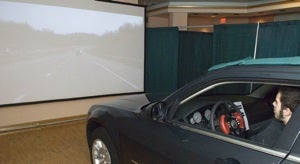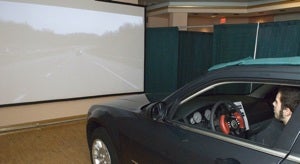 The Rhode Island Department of Transportation, in partnership with the University of Rhode Island, recently completed testing of a unique driving simulation aimed at improving communication to motorists about accidents, construction, general congestion and natural disasters.
The Rhode Island Department of Transportation, in partnership with the University of Rhode Island, recently completed testing of a unique driving simulation aimed at improving communication to motorists about accidents, construction, general congestion and natural disasters.
The results of this study will bolster three years worth of research by Jay Wang, chair and professor of URI’s Department of Industrial and Manufacturing Engineering. The findings will determine the types of electronic messages RIDOT and other states’ transportation agencies will use on dynamic message signs along the highways.
“This research provided the public with a unique chance to have their say and provide valuable input into this real world study,” RIDOT Director Jerome F. Williams said.
The project had two parts, an electronic survey and a behind-the-wheel simulation. Participants sat at a computer to make selections for the type of messages they prefer. A similar testing scenario was also presented in the simulation, which featured a real car parked in front of a projection screen with moving images of a highway and an upcoming message board. As people “drove” toward the board, they indicated their preferences by pressing a button.
Participants were asked their preferences on a number of different types of messages, including congestion, wet pavement, icy conditions, evacuation and hurricane. They were shown signs depicting just text and signs that combine text and graphics. Participants were also asked if they prefer messages in traditional amber color, red or a combination of both colors.
“Dynamic message signs are playing a significant role in our current transportation system,” noted URI Assistant Professor Valerie Maier-Speredelozzi. “Message designs and displays that are easy for drivers to read and understand are the result of research studies like this and others. They help improve the safety of our roads and highways.”
Maier-Speredelozzi said once the survey responses are analyzed, researchers will provide the results to RIDOT for consideration in actual messages. All the alternatives shown during the simulation can be generated by the electronic message boards used by RIDOT.
During the survey phase of the project, which was held in a storefront at Warwick Mall, RIDOT also displayed pieces of Intelligent Transportation Systems (ITS) equipment used by its Transportation Management Center to help alert motorists to problems on the roads. These included a working model of a traffic camera, a Highway Advisory Radio system, and other information about how RIDOT uses ITS to manage traffic on highways throughout Rhode Island.

